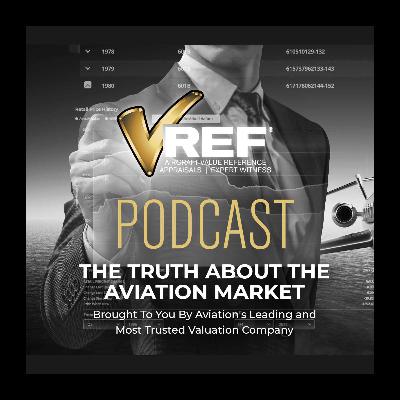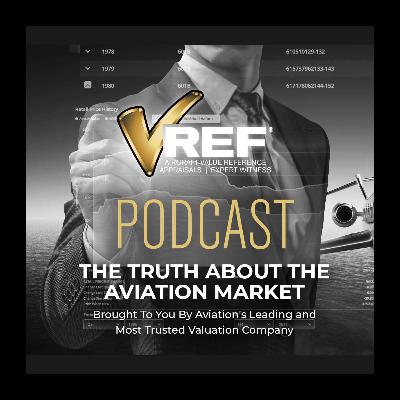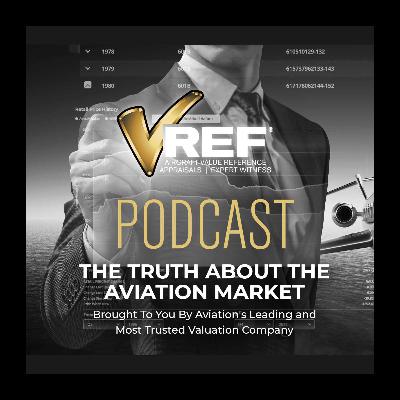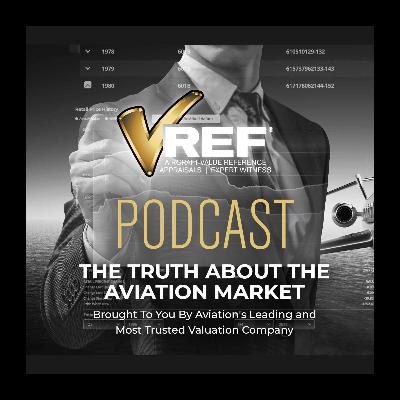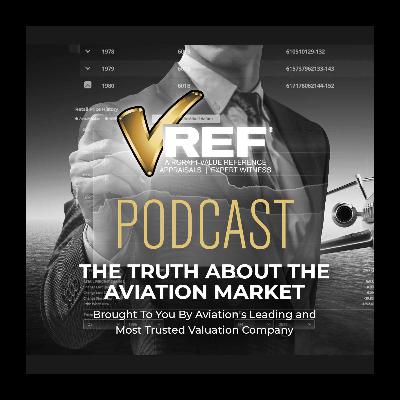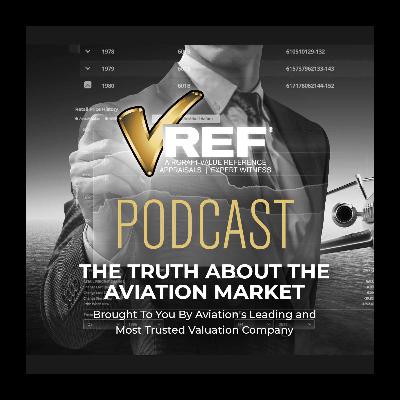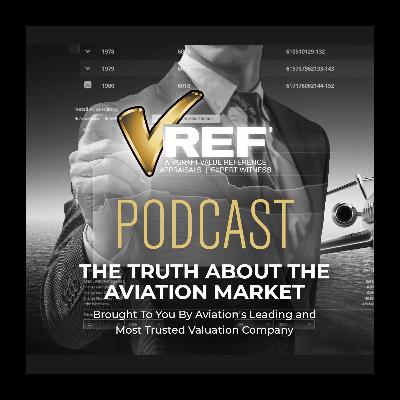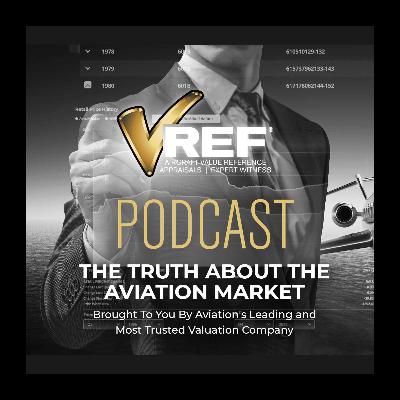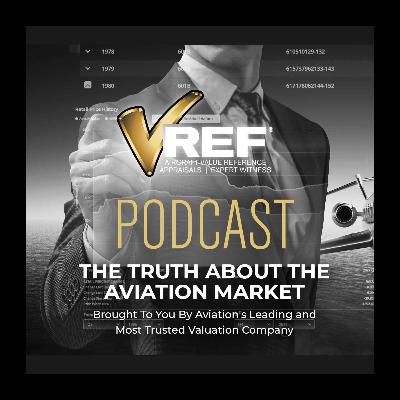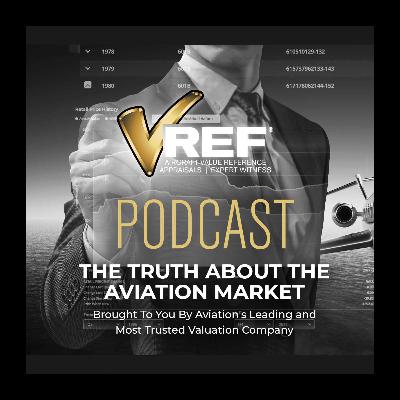Discover VREF | The Truth About the Aviation Market
VREF | The Truth About the Aviation Market

VREF | The Truth About the Aviation Market
Author: Jason Zilberbrand
Subscribed: 2Played: 46Subscribe
Share
© 2025 | VREF Inc | All Right Reserved
Description
Up-to-date information on the state of the aviation marketplace and it's effect on aircraft valuation by the leader in aircraft valuation: VREF Aircraft Value Reference, Appraisal & Litigation Services
14 Episodes
Reverse
Episode OverviewIn this episode, Jason breaks down one of the strangest dynamics to hit aviation in more than a decade — a market that’s slowing down and speeding up at the exact same time. Total transactions are falling… yet the best aircraft are selling faster than they have in years.If you want to understand the real state of the aviation market going into 2026 — not the noise, not the headline spin — this is the episode to hear.This is the truth behind the bifurcation: a clean split between good airplanes and everything else, disciplined buyers and hopeful sellers, supported aircraft with pedigree and those quietly slipping into unsellable territory.Jason unpacks why this market is behaving unlike any cycle we’ve seen — and what it means for values, inventory, operators, lenders, and anyone trying to buy or sell in the next 18 months.What You’ll Discover in This EpisodeWhy the 2025–2026 market is “separating” — not collapsing And how the entire industry is reorganizing itself around that split.Why total transactions are down 17%… but top-tier aircraft are flying off the market in record time And what that contradiction actually means.The silent panic behind the scenes as some sellers still cling to 2021 pricing fantasiesThe surprising aircraft segments with the biggest drops in Days on Market — including one that fell from 105 days to 49Why turnkey aircraft with pedigree are disappearing instantly — while “projects” are becoming nearly unsellableHow a G550 market that had 50+ options suddenly went to zeroWhy the ACJ, 400XP, and GIV markets look completely different than they did a year agoHow shrinking inventory sets up a major snap-back in 2026 when rates fallWhy some new aircraft are UP 12% in value… while mid-aged aircraft are DOWN 13%Why older aircraft are strangely stable — and which fleets are quietly hitting the bottom of their depreciation curveThe real reason costs are exploding across the industry (and why it’s structural, not temporary)What’s actually driving the boom in regional 135 operators — and why their buying power is reshaping the entire used marketWhy off-market deals are rising again — and why almost every long-range sale is happening privatelyHow lenders are thinking heading into 2026 — and why financing will get easier, but not cheaperJason’s Truth“This isn’t a boom and it isn’t a bust — it’s a sorting market. Good airplanes are going to keep selling fast. Mediocre airplanes are going to keep dropping in price. Unsupported airplanes are going to keep sitting. And the buyers who understand that will dominate 2026.”Complete Podcast and show notes can be found at https://vref.com/news/the-weirdest-aviation-market-weve-seen-in-years/Brought to You ByVREF — The Trusted Name in Aircraft Valuations and Appraisals. Whether you operate a piston single, run a fleet, or manage a long-range jet program, VREF keeps you grounded in the only thing that matters: the data.Know what your aircraft is really worth — before you buy, sell, or finance — at vref.com.
Podcast: The Truth About the Market Host: Jason Zilberbrand, President & CTO, VREFEpisode OverviewIn this Thanksgiving special, Jason steps away from depreciation curves, absorption rates, and market chaos to talk about something aviation doesn’t celebrate nearly enough: gratitude.But don’t worry — this isn’t some soft, sentimental detour.This is an episode about the real aviation world we all live in: the chaos, the beauty, the people who keep airplanes flying, the market that refuses to die, and the stories that could only ever happen in this industry.Including the true story of the time Jason simultaneously cooked a Thanksgiving turkey and negotiated the sale of a Global Express with a buyer in Turkey.Episode 13 is part celebration, part confession, part industry-wide love letter — and part reminder that aviation is still here, still resilient, and still miraculous, even in its messiest moments.What You’ll Discover in This EpisodeWhy aviation has perfect comedic timing — and an uncanny ability to humble you at the exact moment you feel invincibleThe overlooked everyday miracles of flyingThe PT6 spool-up.The sunrise on a frozen ramp.The quiet intensity of a controller juggling 18 airplanes and four emergencies.The real backbone of aviation — the invisible people who keep the entire system aliveMechanics. Line techs. Instructors. Avionics wizards. Dispatchers. Ramp crews.The people who show up long before and long after anyone else.The giant truth aviation professionals never say out loud: we are terrible at gratitudeWhy the aviation market simply refuses to die — even after recessions, pandemics, supply-chain collapses, interest rate spikes, and predictions of doomHow passion — not spreadsheets — has kept general and business aviation unbreakableWhy private aviation will always outcompete commercial airlines (and why TSA practically guarantees it)The human side of aircraft values — what every VREF number actually representsA widow settling her husband’s estate.A mechanic keeping a dream alive.A broker grinding until 3 a.m. to get the deal closed.The Thanksgiving Day Global Express story Jason has never told beforeHow he cooked a turkey…while fielding a real-time offer…from a buyer in Turkey…for a large-cabin jet…on a holiday…with a kitchen full of guests.Why, after everything the industry has endured, aviation is still standing — tired, bruised, more expensive than ever… but standingJason’s Truth“Aviation only works because humans show up with pride. Aluminum doesn’t hold this industry together — people do. And passion, more than economics, is why aviation is still here.”...Complete show notes can be found at https://vref.com/news/episode-13-aviation-gratitude-and-a-global-express-11-25-25Brought to You ByVREF — The Trusted Name in Aircraft Valuations and Appraisals.Whether you fly a piston single or manage a business jet fleet, VREF keeps you grounded in data that matters.Know what your aircraft is really worth — before you buy, sell, or finance — at vref.com.
Host: Jason Zilberbrand, President of VREF, ASA appraiser, expert witness, 30+ years in aviation.Episode OverviewIn this episode, Jason pulls back the curtain on one of the most common (and expensive) patterns in aviation: the first airplane someone wants to buy is almost always more airplane than they actually need.From turbocharged SR22s to pressurized pistons with FIKI, Jason unpacks how identity, ego, and fantasy missions push first-time buyers into aircraft that outpace their experience, budget, and real-world flying habits.Instead of shaming the mistake, he explains why it happens, how the “honeymoon period” with a new airplane can wreck a budget, and what you can do to avoid becoming the person who buys their first airplane and sells it six months later in a panic.What You’ll Discover in This EpisodeWhy first-time buyers almost always fall in love with the wrong airplane—and the psychological bias behind it that no one thinks applies to them.The hidden reason the airplane you want at midnight on Controller.com is rarely the airplane you can actually live with.The “honeymoon trap” that quietly turns brand-new owners into desperate sellers within 6 months.Why many “must-have” capabilities—FIKI, turbos, pressurization—become the most dangerous liabilities when you’re new to ownership.The surprising truth about what capability actually costs… and why manufacturers market it as safety.The real reason pressurized piston aircraft vanished from modern production—and why most owners never get told the truth.How to know whether an airplane supports your flying life… or silently owns you.The SR22 Turbo dilemma—and why so many first-time buyers unknowingly set themselves up to fly less, not more.The one question that instantly reveals the aircraft you should buy (and the one you should run from)....moreThe full Podocast with complete show notes can be seen here https://vref.com/news/episode-12-why-your-first-airplane-is-probably-the-wrong-airplane-11-20-25/Jason’s Truth“Your first airplane should be built for the life you’re actually living now—not the one you’re auditioning for. The airplane that fits your mission will support you. The airplane that outpaces your mission will own you.”Mentioned in This EpisodeCessna 182Beech Debonair / early BonanzaPiper ArrowMooney M20JGrumman TigerCirrus SR22 / SR22 TurboFIKI, turbocharging, pressurization systemsWarren Buffett & “No Plane No Gain” campaignBrought to You ByVREF — The Trusted Name in Aircraft Valuations and Appraisals. Whether you’re a first-time buyer looking at a 182 or a seasoned operator trading into a turbine, VREF keeps you grounded in data that matters.Know what your aircraft is really worth—before you buy, sell, or finance—at vref.com.
Podcast: The Truth About the Market Host: Jason Zilberbrand, President & CTO, VREF Length: ~35 minutes Theme: Why aircraft aren’t selling — and what fair market, orderly liquidation, and forced liquidation values really mean when the market slows downEpisode OverviewIn this episode, Jason Zilberbrand takes a hard look at what happens when aircraft stop moving — not just in the air, but in the resale market. From piston singles and turboprops to light jets, days-on-market have tripled since 2022, and many owners are still pricing aircraft like it’s 2021. Jason breaks down how to interpret real market data, why “seller expectation lag” is slowing deals, and what every owner, buyer, and lender needs to understand about fair market, orderly liquidation, and forced liquidation values in today’s environment.In This EpisodeWhy aircraft sit on the market — and how the slowdown is showing across categoriesThe difference between Fair Market Value (FMV), Orderly Liquidation Value (OLV), and Forced Liquidation Value (FLV)What lender portfolios and repossessions reveal about market stressThe top six reasons aircraft don’t sell — from high engine times to missing logbooksHow unrealistic pricing and seller denial are distorting the marketWhy cosmetic neglect, outdated avionics, and incomplete records can kill a dealWhat owners can do now to maintain value and liquidity in a cooling marketKey TakeawaysThe 2021 boom is over. Pricing must follow reality, not nostalgia.FMV ≠ listing price. In this market, true fair value can be 10–20% below asking.Liquidation values matter. Lenders use OLV and FLV to gauge real collateral risk.Engine time is still king. Looming overhauls attract bottom feeders, not retail buyers.Logs sell planes. Missing or incomplete documentation can erase financing options.Cosmetics count. Paint, interior, and presentation drive first impressions — and offers.Jason’s Truth“Price follows demand. Demand follows confidence. Sellers who ignore real data are the ones who sit. If you’re still pricing like it’s 2021, you’re already behind.”The Top 6 Reasons Aircraft SitHigh engine times or upcoming overhauls – scare off retail buyers, attract wholesalersOutdated or inoperative avionics – upgrade costs can exceed aircraft value...Full show notes and podcast can seen at https://vref.com/news/episode-11-when-aircraft-sit-understanding-value-in-a-slow-market-11-12-25Brought to You ByVREF — The Trusted Name in Aircraft Valuations and Appraisals. Whether you fly a piston single or manage a business jet fleet, VREF keeps you grounded in data that matters. Know what your aircraft is really worth before you buy, sell, or finance at vref.com.
Podcast: The Truth About the Market Host: Jason Zilberbrand, President & CTO, VREF Length: ~45 minutes Theme: The global engine crisis—what caused it, how it’s reshaping aircraft values, and what every operator needs to do nextEpisode OverviewIn this episode, Jason Zilberbrand breaks down one of the biggest challenges facing aviation today: the engine shortage. From skyrocketing overhaul lead times to the myth of “guaranteed coverage,” he exposes how years of labor attrition, supply chain collapse, and OEM monopolization have created the perfect storm.If you’ve struggled to schedule an overhaul, find a loaner engine, or even order basic components, this episode connects the dots—showing why downtime is now the single biggest driver of aircraft value and why traditional engine programs may not protect you the way you think they do.With real-world data, case studies, and practical guidance, Jason walks through how operators, brokers, and lenders can survive the shortage and plan ahead in a system stretched to its limits.In This EpisodeHow the “engine crunch” happened: COVID’s ripple effect, early retirements, supply chain failures, and OEM consolidationWhy your engine program isn’t a safety net: The difference between cost protection and availabilityThe CF34 crisis: How one accident triggered a massive industry-wide service bulletinLoaner engines and logistics: Why they’ve become nearly impossible to findHow downtime destroys value: Why a fresh overhaul now adds more resale power than a program contractThe top-overhaul trap: Why partial rebuilds hurt appraisals and financingThe new engine economy: Scarcity, premiums, and a secondary market for “ready-to-run” powerplantsPredictive maintenance: How real-time analytics are reshaping the future of reliabilityKey TakeawaysDowntime is the new currency. The aircraft that fly are the ones that hold value.Coverage ≠ availability. Engine programs manage cost, not capacity.Fresh engines win every time. Overhauled powerplants drive sales, liquidity, and lender confidence.Transparency matters. Maintenance forecasts and SB compliance now make or break deals.Plan a year out. Reserve slots, pre-order parts, and read the fine print—before it’s too late.Jason’s Truth“Coverage doesn’t equal availability. The smartest operators aren’t just paying their hourly rates—they’re planning ahead. Because in this market, downtime kills deals.”... Complete podcast show notes can be found at https://vref.com/news/episode-10/Brought to You ByVREF — The Trusted Name in Aircraft Valuations and Appraisals. Whether you fly a piston single or manage a business jet fleet, VREF keeps you grounded in data that matters. Know what your aircraft is really worth before you buy, sell, or finance at vref.com.VuPf7m4YgUcFwoYeLBxq
Host: Jason Zilberbrand, President & CTO of VREFLength: ~28 minutesEpisode OverviewIn this episode, Jason Zilberbrand takes a hard, unfiltered look at the National Business Aviation Association (NBAA) convention — the industry’s flagship event that once defined dealmaking, advocacy, and innovation in business aviation.But in an era of digital transactions, sustainability mandates, and shifting buyer demographics, is NBAA still relevant? Or has it become a nostalgic echo of what business aviation used to be?Drawing on more than three decades of insider experience — from OEM partnerships to appraisals, advocacy, and firsthand memories of the show’s heyday — Jason explores whether the industry’s premier event is evolving fast enough to meet the realities of today’s market.In This EpisodeHow NBAA became the heartbeat of business aviation — and when it started to lose momentumWhy today’s show feels more like a reunion than a marketplaceThe “static display paradox” — the sustainability hypocrisy no one wants to talk aboutThe vanishing middle of the aircraft market and the industry’s obsession with ultra-long-range jetsHow the next generation of buyers is changing what success looks like in private aviationWhy today’s wealth prefers discretion over displayThe Phenom 300 case study — proof that practicality still winsA blueprint for how NBAA could evolve: digital engagement, data access, and meaningful innovationKey TakeawaysNBAA isn’t dead — but it’s at a crossroads. Its future depends on whether it adapts to new buyer values and modern expectations.Optics have replaced operations. Today’s trade show feels more performative than productive — and that’s a problem.The industry’s middle market is missing. Between turboprops and $80M long-range jets, there’s a massive gap waiting to be filled.Younger generations buy differently. They want efficiency, data, and discretion — not photo ops.Sustainability needs authenticity. The static display’s waste contradicts the industry’s green messaging.It’s time for a new model. NBAA could evolve into a year-round digital platform for verified data, advocacy, and true innovation.Jason’s Truth“Not every buyer wants a floating boardroom. Some of us just want a reliable airplane that gets us where we need to go without burning through a trust fund. Innovation shouldn’t mean bigger and more expensive — it should mean smarter, leaner, and built for people who actually fly.”Mentioned in This EpisodeNBAA Business Aviation Convention & ExhibitionEmbraer Phenom 300 & Praetor 500Gulfstream G550, Dassault Falcon 7XTextron Aviation, JSSIEAA AirVenture and Sun ’n FunVREF Online Aircraft Valuation PlatformBrought to You ByVREF — The Trusted Name in Aircraft Valuations and Appraisals. Whether you fly a piston single or manage a business jet fleet, VREF keeps you grounded in data that matters. Know what your aircraft is really worth before you buy, sell, or finance at vref.com.The full show notes can be see at https://vref.com/news/episode-9-is-nbaa-still-relevant-and-what-it-says-about-the-future-of-business-aviation-10-30-25/
Host: Jason Zilberbrand, President of VREF, ASA appraiser, expert witness, 30+ years in aviation.Topic: The messy middle between accepted offer and title transfer—what’s supposed to happen, what actually happens, how deals go off the rails, and how to protect yourself.Episode SummaryJason pulls the curtain back on the transaction phase: LOIs, deposits, pre-buys, escrow, title and liens, and closing mechanics. You’ll learn why “time kills deals,” the most common failure points, and how psychology, paperwork, and poor preparation can turn a routine purchase into a costly, month-long fight. Jason also walks through a real “deal from hell” that morphed from a 30-day plan into a multi-year headache—and the concrete lessons it left behind for buyers, sellers, brokers, lenders, and escrow.Key TakeawaysTime kills deals. The longer a transaction drags, the more uncertainty, second-guessing, and failure points creep in.Process over fairy tales. Perfect two-week closings with flawless logs are outliers; plan for friction.Paper beats promises. A clear, signed LOI is the roadmap. Without it, you’re gambling.Pre-buy is non-negotiable. Skipping it is how small problems become existential ones.Escrow is protection, not a formality. Read the agreement; demand transparency; verify ownership, liens, and title.Soft markets amplify friction. Buyers press leverage, sellers panic over carrying costs, lenders get cautious.Airplanes don’t kill deals—people do. Ego, impatience, and poor communication are the real culprits.The Ideal Transaction Flow (What Should Happen)Letter of Intent (LOI) signedDefines terms, pre-buy scope, who pays for what, defaults, closing mechanics.Sent to escrow.Deposit to escrow (5–10%)Typically refundable until technical acceptance; then it goes “hard.”Required before lender issues a funding commitment.Pre-buy inspection (at OEM-authorized or reputable independent facility)Logbook review, borescope, engine runs, oil analysis, known trouble spots.Confirms serials on engines/props/APU; surfaces corrosion and compliance gaps.More show notes can be found at https://vref.com/news/episode-8-time-kills-deals-how-aircraft-transactions-really-close-and-blow-up-10-23-25Resources MentionedIf you’re preparing to buy or sell, don’t guess. Ground your decisions in real data with VREF Online and avoid the traps discussed in this episode.VREF Online — Real-time aircraft values, operating cost estimates, and depreciation forecasts for 900+ models. Make decisions with data, not hunches. https://vref.com/vref-online-aircraft-valuation-platform/Listen to Past EpisodesEpisode page: https://vref.com/news/category/podcast/
Host: Jason Zilberbrand, President of VREF Aircraft Value Reference & Appraisal ServicesSummaryIn one of the most revealing episodes yet, Jason pulls back the curtain on three of the aviation industry’s most misunderstood—and often misused—practices: off-market aircraft, back-to-back transactions, and the broker’s role in 2025. He explains why these deals tempt buyers and sellers alike with promises of speed, exclusivity, and discretion—and why, more often than not, they lead straight into confusion, inflated prices, and even fraud.Drawing on decades of hands-on experience as a dealer, appraiser, and expert witness, Jason dissects how these structures work, where they go wrong, and how a skilled broker can be the difference between a seamless closing and a financial disaster.Topics CoveredThe Illusion of the “Off-Market” AdvantageWhy exclusivity, speed, and confidentiality attract buyers.How real off-market opportunities differ from rumor-based listings.The role of trusted broker networks in legitimate private transactions.When “Off-Market” Turns UglyThe dangers of price opacity and multiple false listings.How missing serial numbers, fake mandates, and altered specs erode trust.Case examples of fraudulent transactions, missing logbooks, and hidden liens.Why buyers have fewer consumer protections purchasing an aircraft than a car.Understanding Back-to-Back TransactionsWhat a back-to-back actually is—and why it’s often misunderstood.How they’re used to disguise markups, hide commissions, or inflate prices.Real-world consequences: lawsuits, escrow confusion, and legal exposure.The rare cases where a properly disclosed back-to-back can serve a legitimate purpose.Historical Context and Modern ParallelsHow the Wright Brothers’ early sales disputes mirror today’s representation chaos.Why transparency problems have been baked into aviation since its inception.More show notes can be found at https://vref.com/news/episode-7-the-truth-about-off-market-aircraft-back-to-back-deals-and-why-you-still-need-a-broker-10-16-25/Quotable Moments“You have more consumer protection buying a dishwasher than buying an airplane.” “Transparency isn’t bureaucracy—it’s protection.” “A good broker is your shield. A bad deal is your lawsuit waiting to happen.”Listen NowHear Episode 7 of The Truth About the Market wherever you get your podcasts, or stream it directly at VREF.com/podcast.Call to ActionTo explore current aircraft values and learn how real-world transparency impacts pricing, visit VREF.com. For market data, appraisals, or guidance on your next acquisition or sale, contact jason@vref.com.
Host: Jason Zilberbrand, President of VREF Aircraft Value Reference & Appraisal ServicesOverviewIn this episode of The Truth About the Market, Jason turns the spotlight on the aviation community itself. Drawing from the latest VREF Market Sentiment Survey, which gathered responses from over 1,000 buyers, sellers, brokers, lenders, and operators, he breaks down what people across the industry are seeing, feeling, and planning for as 2025 comes to a close.From shifting inventory trends and rising operating costs to tightening loan conditions and the widening gap between buyer optimism and seller expectations, Jason walks through the key insights that define today’s market. This isn’t speculation—it’s a direct look at what aviation professionals are actually saying about the year ahead.In This EpisodeMarket Mood: The community is evenly divided between optimism, caution, and pessimism—a sign of a truly transitional market.Inventory Trends: Aircraft are taking longer to sell as buyers slow down and sellers recalibrate pricing.Financing and Affordability: Interest rates, stricter LTV ratios, and higher costs are reshaping purchase behavior across all segments.Maintenance and Upgrades: MRO backlogs, high costs, and split opinions on engine programs are affecting both resale and operations.Regional Differences: U.S. respondents cite financing concerns, Europeans focus on sustainability, Latin Americans on parts and skilled labor, and Middle Eastern and Asian buyers on access to new aircraft.Buyer Priorities: Transparency, clear pedigree, fewer pre-buy surprises, and more flexible lending options top the list of what customers want most.Market Heat Map: Jason identifies which aircraft are selling fast, which are stabilizing, and which are now deep in buyer’s market territory.Negotiation Strategy: How to read days-on-market data, act decisively in hot segments, and stay patient when leverage shifts.Jason’s Takeaway“We’re not looking at a collapse—we’re looking at normalization. The frenzy is over, and the market is finding its balance again. This is where informed buyers and realistic sellers both win. In aviation today, certainty and clarity are the new currency.”Listen Now If You Want ToUnderstand how your peers are viewing the next 12 months of the marketLearn which aircraft segments are holding value and which are softeningGet Jason’s guidance on pricing, financing, and remarketing strategyBenchmark your expectations against real, data-backed industry sentimentSee the Full ReportFor charts, detailed breakdowns, and Jason’s complete written analysis of the 2025 VREF Market Sentiment Survey, visit vref.com/results.
Host: Jason Zilberbrand, President of VREF Aircraft Value Reference & Appraisal ServicesIntroduction“Can I afford that airplane?” Jason tackles the question he hears every week—moving past listing prices to the real math behind financing structures, down payments, LTV, amortization, liquidity and net-worth requirements, fixed vs. variable operating costs, and practical rules of thumb. With real aircraft examples and monthly/annual budget breakdowns, this episode shows how to evaluate affordability without getting blindsided.Topics Covered1) Myth-Busting: Asking Price ≠ AffordabilityAffordability = (Upfront cash) + (Financing terms) + (Ongoing operating costs).Airplanes are more like commercial assets than cars; regulations and maintenance make the cost stack steeper and more complex.2) How Aircraft Financing Really WorksLoan-to-Value (LTV): Typical ranges 70–85%; older/large-cabin jets often tighter.Down payment: Usually 15–30% of purchase price (or appraised value, if lower).Terms & amortization: Commonly 5–15 years; balloons frequent on larger jets.Rates (contextual): Recent deals in the low-to-mid 6–7% range, credit- and asset-dependent.Credit vs. collateral: Most lenders are credit-first; collateral-based loans trade speed for higher rates, bigger down, stricter covenants, reappraisals, and faster repos if covenants break.3) Real-World Examples (Illustrative Math)Citation (light jet), $3.5M:25% down = $875k; finance $2.625M @ ~7.25% / 15 yrs ≈ $23.8k/mo debt service.Add maintenance reserves/programs ≈ $10–15k/mo (contextual).Typical expectations: net worth $10–15M, liquidity ≈ 10–15% of loan + 12 months payments.Complete show notes at https://vref.com/news/episode-5-can-i-afford-that-airplane-9-29-25Closing & Next EpisodeEpisode 5 lays out the real math of ownership so you can answer, “Can I afford that airplane?” with confidence.Next up: deeper dives into DOC/FOC modeling and how to structure ownership (solo, fractional, partnerships) without blowing up your budget—or your relationships.Let VREF help you value your aircraft
IntroductionA single dent can erase seven figures from a jet’s value. In this episode, Jason unpacks one of aviation’s most misunderstood—and expensive—topics: damage. Drawing on decades of appraising, federal litigation experience, and a personal war story (a Lear 45 tail strike in a hangar), he explains why damage isn’t a checkbox or a one-size deduction. It’s a nuanced blend of market psychology, documentation, repair quality, and timing—and getting it wrong can cost millions.Topics Covered1) Why Damage Matters (and What It Isn’t)Diminution of value ≠ airworthiness. Returning an aircraft to service doesn’t erase market stigma.Emotional and reputational effects drive real pricing outcomes—especially with high-value business jets.Comparables from other asset classes (exotics, vintage instruments): pedigree and history reshape demand.2) Core Valuation Criteria for DamageDynamic vs. static incidents: under power/motion typically carries larger deductions than at-rest/tow events.Repair method & provider: OEM/authorized facilities and factory parts are rewarded by the market; third-tier or vague repairs increase stigma.Workscope & records: completeness, clarity, and no “pencil-whipped” entries; missing logs create pedigree risk and amplify buyer scrutiny.Searchability & publicity: online news/photos can permanently brand an airframe, regardless of technical repair quality.Asset & market context: age, cycles, engine programs, fleet size, buyer demand, and inventory levels influence how much discount the market demands.3) Market Cycles & StigmaTight inventory = more forgiveness. Hot markets (e.g., COVID era) moved damaged aircraft with smaller discounts.Soft markets = bigger discounts. When buyers have choices, stigma costs more.4) Science vs. ArtScience (measurable): equipment list, repair invoices, sales history, fleet behavior.Art (buyer psychology): two identical aircraft—only one with a damage entry—rarely trade for the same number.See full show notes at .... https://vref.com/news/episode-4-how-does-damage-effect-aircraft-value/Closing & Next EpisodeEpisode 4 demystifies damage—what actually drives value hits and how to recover them. Next up: real-world damage war stories, deeper dives on documentation pitfalls, and how to price stigma over time. Subscribe on your favorite platform and reach Jason at Jason@vref.com if you want a case discussed (anonymized) in a future episode.Podcast theme music by Transistor.fm.
Host: Jason Zilberbrand, President of VREF Aircraft Value Reference & Appraisal ServicesIntroductionJason pulls back the curtain on aircraft valuation—what it is, what it isn’t, and how bad inputs (or bad actors) can warp the number you’re relying on. Building on Episode 2 (bonus depreciation myths and popularity traps), this episode shows exactly how to value an aircraft and how the new VREF software makes the process transparent, defensible, and repeatable for buyers, sellers, brokers, lenders, and insurers.Topics Covered1) Why Aircraft Valuation Is Harder Than Cars, RVs, or BoatsSmall fleets, unique histories, and limited public sales data.“Comps” without context are dangerous—closing numbers rarely reveal the real configuration, condition, or concessions.2) The Good: A Correct, Defensible Valuation WorkflowEnter the fundamentals correctly: airframe time, engine time since overhaul, accurate TBO (now fully editable in VREF), program status (on/off), paint/interior condition, avionics, and STCs.VREF outputs multiple value types: Fair Market (Retail), Wholesale, Orderly Liquidation, Forced Liquidation, Inventory, Scrap—with clear use cases.What each means (plain English):Fair Market (Retail): USPAP/IRS/ASA-defined “willing buyer/willing seller” in open market—this is the everyday benchmark.Orderly Liquidation: distressed sale, broker has time to sell post-default/repo.Forced Liquidation: auction-level distress—sell fast, get what you can.Inventory Value: dealer carry-cost perspective (e.g., ~90 days).Wholesale: multi-unit discount or special-use/soft markets; use sparingly for common aircraft.Scrap (not Salvage): raw metal value if no productive use remains; salvage/parting-out is too variable for software (consulting required).3) The Bad: Common User Errors That Skew ValuesMissing overhaul status or using “top overhaul” in the major overhaul box (don’t).Forgetting to toggle engine program coverage.Over-crediting avionics or double-counting options (e.g., Cirrus SR22 GTS options applied twice).Skipping the condition tab (leaving $50–60k on the table on pistons with fresh paint/interior).Not crediting factory reman, hot sections, or midlife on turbines.Confusing asking prices with actual market (throw out the extremes; many listings are aspirational or strategic)....NOTE: you can see full content description at https://vref.com/news/episode-3-the-good-the-bad-and-the-manipulated-how-aircraft-valuations-really-work
Host: Jason Zilberbrand, President of VREF Aircraft Value Reference & Appraisal ServicesIntroductionIn this episode of The Truth About the Market, VREF CEO Jason Zilberbrand pulls apart two of the biggest myths driving poor aircraft buying decisions: the illusion of “free jets” through bonus depreciation, and the herd mentality of chasing the most popular aircraft rather than the one that fits your mission and budget.Jason brings over three decades of valuation expertise and market cycle experience to expose the hard truths behind aircraft ownership—and why Instagram hype, LinkedIn posts, and sales pitches often distort reality.Topics Covered1. The Bonus Depreciation MythHow bonus depreciation actually works versus how it’s sold.Why you only benefit if you already have large, predictable taxable income.The realities of debt service, operating costs, and the IRS’s recapture rule upon resale.Why jets are never “free”—and how misusing tax rules can lead to massive surprises later.2. The Aircraft Popularity ContestWhy buyers often choose aircraft based on hype, brand image, or peer influence.The long-term pitfalls of buying too big, too old, or too trendy.Why the strongest buys are often the less “sexy” aircraft—trainers, turboprops, mid-cabins—with deeper support networks and lower operating costs.How fractional operators and fleet owners dominate certain markets and leave individual buyers holding the bag when values collapse.3. The Reality of Aircraft OwnershipThe hidden costs and attention that come with operating a jet.Why ownership is never just the bill of sale—it’s ongoing maintenance, crew, support, and unpredictability.Jason’s own experience with the “honeymoon period” of ownership and how quickly the bills (and mechanical surprises) add up.Hear the podcast and see the full show notes at https://vref.com/news/episode-2-the-free-jet-myth-the-aircraft-popularity-contest-8-26-25/Contact: 📧 Jason@vref.com 🌐 vref.com
Host: Jason Zilberbrand, President of VREF Aircraft Value Reference & Appraisal ServicesIntroductionHi everyone, and welcome to the very first episode of The Truth About the Market.I'm your host, Jason Zilberbrand—President of VREF, long-time aviation appraiser, and someone who's spent over three decades deep in this industry. I've worked with everyone from individual owners to Fortune 50 operators. I've testified as an expert witness in major litigation. I've seen more cycles than I can count.This podcast is about cutting through the BS—no fluff, no marketing spin, no sponsors. Just the unfiltered truth about aviation, aircraft values, and the industry trends that actually matter.Today, we're tackling three big topics:The summer slowdownThe impact of tariffs and supply chain issuesWhat the back half of 2025 might actually look likeThe Pre-Owned Aircraft Market is SofteningWhat everyone sees—but not everyone wants to admit—is that the pre-owned aircraft market is softening quickly.Inventories are rising across the board.Days on market are increasing.Even normally insulated categories like medium jets, light jets, and turboprops are affected.Prices are coming down.Many buyers are sitting on the sidelines, waiting for direction. Geopolitical instability—two escalating wars and the potential for U.S. involvement—certainly isn't helping.Beyond Geopolitics: The Bigger PictureWhile wars, interest rates, and stock market health are important, they don't fully explain the current shift. Looking at the bigger picture:Sales requests and financing requests are slowing.Defaults are starting to rise.This isn't the usual seasonal pattern.Seasonal Slowdowns vs. This SummerFor those new to the industry, summer is often slower:Owners use their aircraft for vacations and events.Kids are out of school.Dealers prepare inventory in winter for spring sales.On the business jet side, summers have historically been so slow that brokerages sometimes closed early on Fridays. But this summer feels different—there's more going on.Post-COVID Market CycleTypical ownership cycles run 3–5 years. Many aircraft bought during the post-COVID buying rush are now hitting the market—often at overpaid prices.Prices are correcting back to pre-COVID levels.Demand is also back to pre-COVID norms.Trainer aircraft (C172, DA20, C182) remain strong due to limited supply, but all aircraft have a natural price ceiling—when they get too expensive, they compete with higher-category aircraft.......Hear the podcast and see the full show notes at https://vref.com/news/the-truth-about-the-aviation-market-episode-1-8-8-25/Contact: 📧 Jason@vref.com 🌐 vref.com


